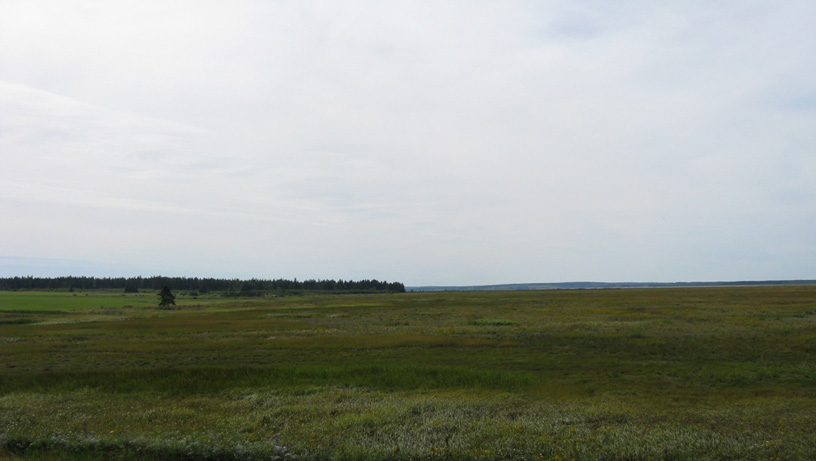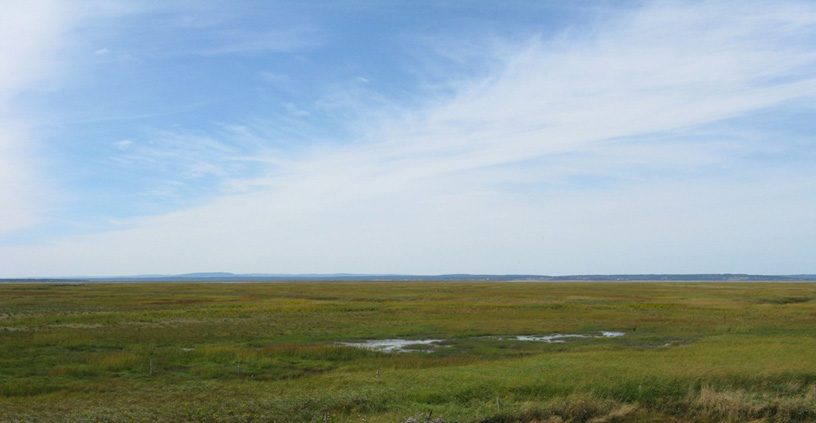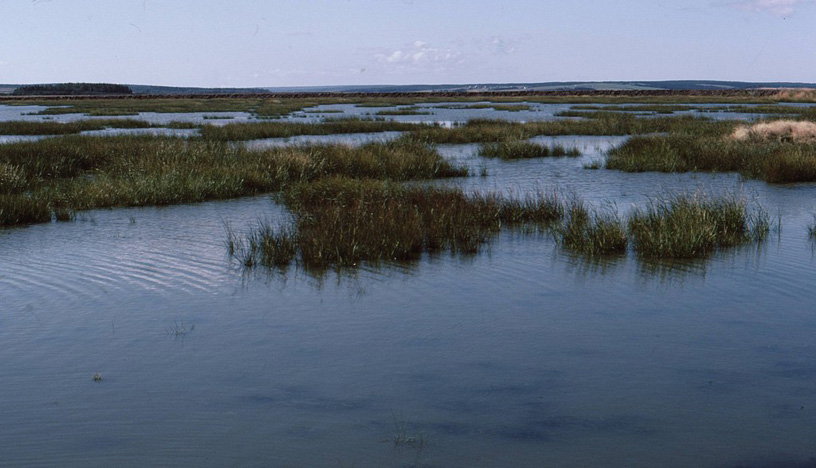John Lusby Marsh National Wildlife Area Management Plan, 2016: chapter 2
2 Ecological resources
2.1 Terrestrial and aquatic habitats
The plant cover of the marsh is an assemblage of different communities ranging from almost pure stands of a single species to associations of several species (Figures 10 and 11). The community arrangement is generally controlled by the height of the tides (Olsen et al. 2005). Each species responds to a specific flooding regime (the frequency and duration of salt water inundation), soil drainage and salinity. The most prominent species are the cordgrasses (Spartina patens and S. alterniflora), Goose Grass (Puccinellia maritime), Samphire (Salicornia europaea), and Seablite (Suaeda maritime). Lower sections of the marsh, dominated by Spartina alterniflora, are flooded twice daily. The entire marsh including the upper elevations (S. patens marsh) is usually flooded only during the highest "spring" tides; the height of these tides can vary considerably throughout the year and during the 18-year tidal cycle (Van Zoost 1970; Desplanque and Mossman 2004; Flanary and Chmura 2007).
There are no reports of sudden vegetation dieback in Bay of Fundy or Atlantic Canada salt marshes. The causes of sudden vegetation dieback, where Spartina alterniflora suddenly dies and does not grow back, are not definitively known, but several correlates, such as eutrophication, have been identified in the reported cases throughout the Atlantic and Gulf coasts (Alber et al. 2008; Elmer et al. 2012). Phragmites sp. is present in Atlantic Canada salt marshes, but Phragmites sp. has not had a negative impact on salt marshes in the John Lusby Marsh NWA or other salt marshes in Atlantic (Hanson 2004; Hanson and Shriver 2006; Saltonstall 2003; Weinstein et al. 2003). In contrast, freshwater moist soil locations have seen expansive growth of Phragmites sp. in recent years (Hanson pers. obs.) and may be related to the more invasive form of Phragmites sp., which has been confirmed to be present in Atlantic Canada (Saltonstall 2003; Hanson pers. obs.).
Two small impoundments totalling 20 ha were developed in collaboration with Ducks Unlimited Canada along the upland fringe of the marsh (MacKinnon et al. 1985). These are shallowly flooded by brackish water and vegetated predominantly by Widgeon grass (Ruppia maritima) and cordgrass.


2.2 Wildlife species
2.2.1 Birds
The principal importance of the John Lusby Marsh National Wildlife Area (NWA) is as a staging and migration site for waterfowl (Bateman 1973; Bateman 1974; Barkhouse 1985; Barrow 1985). The two freshwater and brackish impoundments, particularly the Burgess Impoundment, are also important to migrating shorebirds (MacKinnon et al. 1985). Within the impoundments, waterfowl such as Black Duck (Anas rubripes), Northern Pintail (Anus acuta), Green-winged Teal (Anas carolinensis), Blue-winged Teal (Anas discors) and American Wigeon (Anas americana) are the most abundant. The many tidal pools and salt marsh ponds are also valuable habitat for a variety of migrating shorebirds. A few species, such as the Willet (Tringa semipalmata), are summer residents. Other species observed over the marshes include Bald Eagle (Haliaeetus leucocephalus), Osprey (Pandion haliaetus), Rough-legged Hawk (Buteo lagopus) in winter, Red-tailed Hawk (Buteo jamaicensis), Northern Harrier (Circus cyaneus), Peregrine Falcon (Falco peregrinus) and Short-eared Owl (Asio flammeus).
The Burgess Impoundment supports a variety of migrant shorebird species from late July to August each year (MacKinnon et al. 1985), particularly if a dry summer exposes the mudflats within the shallow impoundment (Table 3). Common species within the NWA include Willet (Tringa semipalmata), Common Snipe (Gallinago gallinago), Spotted Sandpiper (Actitis macularius), Lesser Yellowlegs (Tringa flavipes), Greater Yellowlegs (Tringa melanoleuca), Short-billed Dowitcher (Limnodromus griseus), Black-bellied Plover (Pluvialis squatarola), Semipalmated Plover (Charadrius semipalmatus), Semipalmated Sandpiper (Calidris pusilla) and Least Sandpiper (Calidris minutilla).
2.2.2 Mammals
Few mammal species are found regularly on John Lusby Marsh NWA, which is comprised predominantly of salt marsh habitat. Meadow Voles (Microtus pennsylvanica) are abundant on the higher ground and upland fringe. Most of the typically common species for mainland Nova Scotia would be expected to at least frequent the area. Particularly common species would be Eastern Coyote (Canis latrans), Red Fox (Vulpes vulpes), Muskrat (Ondatra zibethicus), Raccoon (Procyon lotor), Striped Skunk (Mephitis mephitis), Mink (Neovison vison) and White-tailed Deer (Odocileus virginianus) (Banfield 1974; Gilhen and Scott 1981; Dawe 2004).
2.2.3 Reptiles and amphibians
As the NWA is predominantly salt marsh, no reptile or amphibian species have been documented at this site, although common species such as Garter Snake (Thamnophis sirtalis) would be expected along the upland fringe (Brannen 2001).
2.2.4 Fish
Numerous tidal creeks cut their way through the salt marsh portion of John Lusby Marsh NWA. As well, tidal pools exist in the salt marsh at low tide. Typical salt marsh tidal pool species expected to occur are Mummichog (Fundulus heteroclitus) and Fourspine Stickleback (Apeltes quadracus).
2.3 Species at Risk
No species at risk breed within John Lusby Marsh NWA, although Peregrine Falcons are common spring and fall transients. There are three active Peregrine nests within 50 km of the NWA.
2.4 Invasive species
Generally, salt marshes are an environment where only specialist salt-tolerant plants can survive. The majority of this NWA is populated by plants such as Spartina alterniflora, S. patens and S. pectinata. At present, there are no recognized invasive species within the John Lusby Marsh NWA.
